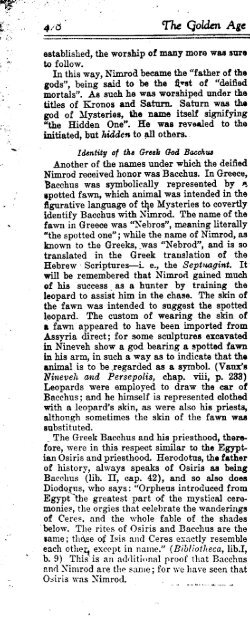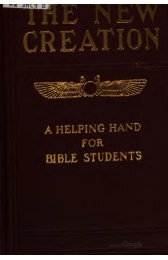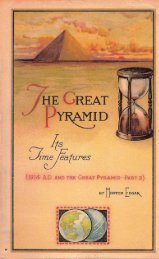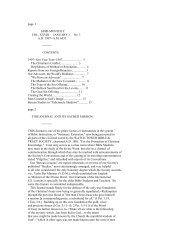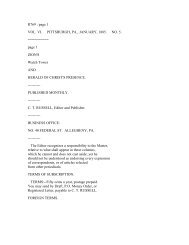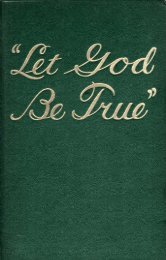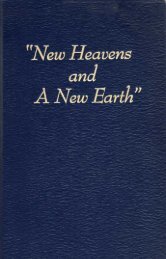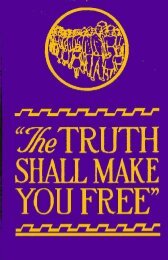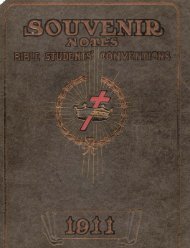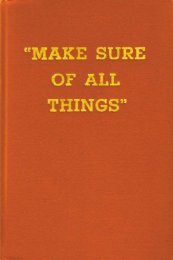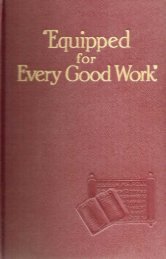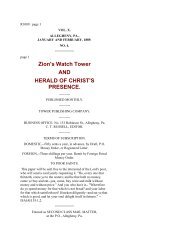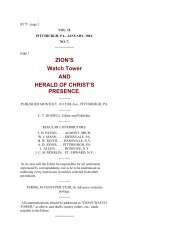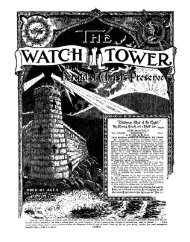The Watchtower Society and John and Morton Edgar - A2Z.org
The Watchtower Society and John and Morton Edgar - A2Z.org
The Watchtower Society and John and Morton Edgar - A2Z.org
- No tags were found...
Create successful ePaper yourself
Turn your PDF publications into a flip-book with our unique Google optimized e-Paper software.
4*6 <strong>The</strong> Golden Age for MQ 11, 192~ : A' -..-- ..-..--.-" .---I-.-established, the worship of many more was sure <strong>The</strong> ivy, so conspicnons in all Bacchanalianto follow.oelebrations, was an express symbol of Nimrod.In this way, Nimrod became the "father of the <strong>The</strong> Greek word for ivy is '~ssosJ'; <strong>and</strong> Kissosgods", being said to be the of "deified was one of the titles of Bacchus. (Panssniaa,mortals". As such he was worshiped under the Attica, cap. 31, p. 78) Now, the name of thetitles of Gonos <strong>and</strong> Saturn. Saturn waa thR desaendants of hsh was pronounced in &WO@ .god of Uysteries, the name itself signifying "Kissioi". (Strabo, lib. XV, p. 691) <strong>The</strong> iv ."the Hidden One". He was reveded to the branch carried by the votaries of Bacchus, the* ,initiated, but hidden to dl others.fore, signified to the initiated that Bacchus warthe "branch of Cash"-that is, Nimrod, the sonIdentity of the Greek God Bacchw of hh. This also accounts for om of the tifJesbother of the names under which the deified of the Greek god Apollo-"Kissens Apollon".Nimrod received honor was Bacchus. In Greece, It serves to identify Apollo with Nimrod (amongBacchus was symbolically represented by 8 other pronfa), meaning literally "<strong>The</strong> Cushite 'ppotted fawn, which animal was intended in the Apollo''.figurative language of the Mysteries to covertly ' From Anaoreon (p. 296) we learn that anidentifyBacchus with Ximrod. <strong>The</strong> name of the other of the titles of Bacchus was "Aithiopais",fawn in Greece was Tebros", meaning literally which means "the son of lEthiopsy'. We haw"the spotted one"; while the name of Nimrod, as already pointed out that the Ethiopian8 wereknown to the Greeks, .was "Nebrod", <strong>and</strong> is so descendants of Cush, <strong>and</strong> therefore rEthiupstranslated in the Greek translation of the must have been Cnsh himself. (See the marginalHebrew Scriptures-i. e., the Septuugint. It reading of Habakkuk 3 : 7)will be remembered that Nimrod gained much <strong>The</strong> literal meaning of the word Bacchus isof his success , as a hunter by training the "the lamented one", being derived from Bakhahleopard to assist him in the chase. <strong>The</strong> skin of "to weep9'or 'lament". Hesychius (p. 179) saysthe fawn was intended to suggest the spotted that among the Phenicians 9acchos mean4 .leopard. <strong>The</strong> custom of wearing the skin of weeping". <strong>The</strong> Hebrew word used in the Biblea fawn appeared to have been imported from for weeping <strong>and</strong> lamenting is Baua, or Bakah.Assyria clirect ; for some sculptures excavated (See Psalm 84: 6, where the word Baca appearsin Nineveh show a god bearing a spotted fawn untranslated-"valley of Baca" should readin his arm, in such a way as to indicate that the '%alley of' weeping") On certain mystic Baoanimalis to be ,regarded as a symbol. (Vanx's chanalian festivals a spotted fawn was torn inNineveh md Persepolis, chap. viii, p. 233) pieces, <strong>and</strong> great lamentations were mads.Leopards were employed to draw the car of Photins tells us the significance of this cere-Bacchus ; <strong>and</strong> he himself is represented clothed mony: "<strong>The</strong> tearing in pieces of the nebroi [orwith a leopard's skin, as were also his priests, spotted fawns] was an imitation of the sufferingalthongh sometimes the skin of the fawn was in the case of Dionysus" or Bacchns. (Photins,substituted.Laxiom, pars. I, p. 291) Thus the great larnen-<strong>The</strong> Greek Bacchus <strong>and</strong> his priesthood, them tations which followed the violent death offore, were in this respect similar to the Egypt- Nimrod (Nebrod), when his body was torn intoian Osiris <strong>and</strong> priesthood. Herodotns, the father fourteen pieces by the judges of Egypt, wasof history, always speaks of Osiris aa being annually commemorated by the various natio&Bacc1:us (lib. 11, cap. 42), <strong>and</strong> so also does <strong>The</strong> backsliding women of Israel wept forDiodo,rus, who says: "Orphens introduced from the death of the false Messiah under the nameEgqpt"the greatest part @f the mystical cere- of Tamrnnz, in memory of the wailing of Semimonies,the <strong>org</strong>ies that celebrate the w<strong>and</strong>erings ramis for the death of Nimrod. Ezekiel 8: 1S,14,of Ceres. <strong>and</strong> the ~vhole fable of the shades reads: "Turn thee yet again, <strong>and</strong> thou shalt ssebelow. <strong>The</strong> rites of Osiris <strong>and</strong> Bacchus are the greater abominations that they do. <strong>The</strong>n hesame; tllwe 4' Isis mid Ceres exactly resemble brought me to the gate of the Lord's houseeach other, esccpt in name." (Bibliotl~eca, lib.1, which was toward the north; <strong>and</strong>, behold, thereb. 9) This is an acl(litiona1 proof that Bacchus sat women weeping for Tammaz." It is signnclSinirod are the Silnle; for we have seen that nificant that these wmen sat at the north gate,Osiris \\-as Simrocl. - --.... -- - the same place as the seat of the "image ofF41.. 1?


